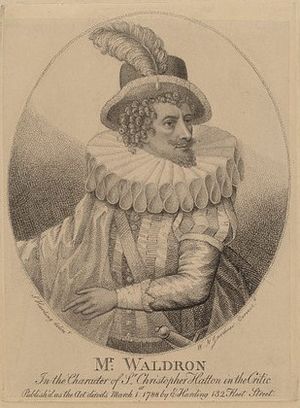Francis Godolphin Waldron facts for kids
Francis Godolphin Waldron (1744–1818) was an English writer and actor. He was also known as an editor and bookseller. He lived a long time ago, in the 1700s and early 1800s.
Contents
Life Story of Francis Waldron
Francis Waldron started his career as an actor. He joined David Garrick's acting company at Drury Lane Theatre in London. His first known performance was in 1769. He played a part in a play called A New Way to Pay Old Debts. Later, in 1771, he appeared in The Constant Couple.
Acting and Management Roles
Waldron did not become a very famous actor. However, David Garrick, a well-known theatre manager, gave him an important job. Waldron was put in charge of a special fund for actors that Garrick started in 1766.
Waldron also managed several country theatres, including those in Windsor and Richmond. He sold the Windsor theatre in 1791.
Plays and Performances
Waldron often performed in new plays. In 1772, he was the first Sir Samuel Mortgage in a play called Humours of the Turf. He also wrote his own plays. In 1773, he performed in his comedy Maid of Kent. This play was based on a story from a famous old magazine called The Spectator.
He also wrote Contrast, or the Jew and Married Courtezan in 1775, but it was only performed once. Waldron continued to act in various roles, including Shallow in Merry Wives of Windsor. In 1783, his comedy Imitation was performed. It was a funny reversal of another play, The Beaux' Stratagem, where women played men's roles and men played women's roles.
Later Career
In 1793, Waldron played a new character, Sir Matthew Medley, in a play called My Grandmother. He still appeared occasionally at Drury Lane Theatre. In 1795, he was the first Prompter in George Colman's New Hay at the Old Market. For his own special performance night, he put on two of his own plays: Love and Madness and Tis a wise Child knows its own Father. Neither of these plays was printed.
Waldron continued to appear on stage until close to the end of his life. His son, also named Waldron, sometimes acted with him. Francis Godolphin Waldron passed away in March 1818.
Works by Francis Waldron
Francis Waldron was a busy writer and editor. He wrote many plays and also adapted older ones.
Plays and Adaptations
In 1783, Waldron published a work that tried to finish a famous poem by Ben Jonson called The Sad Shepherd. He also adapted older plays. For example, The King in the Country (1789) was a changed version of a play by Thomas Heywood.
His play Heigho for a Husband (1794) was a new version of his earlier play Imitation. This one was more successful and was performed at the Haymarket Theatre. He also adapted The Fatal Extravagance by Aaron Hill into a play called The Prodigal (1794), giving it a happy ending.
Waldron wrote a five-act play called The Virgin Queen (1797), which was a follow-up to Shakespeare's The Tempest, but it was never performed. He also wrote The Man with two Wives, or Wigs for Ever (1798). In 1804, his comic opera The Miller's Maid was performed. It was based on a story by Robert Bloomfield and was quite popular.
Editing and Other Writings
Waldron also worked as an editor. In 1789, he published a new edition of Roscius Anglicanus, a historical book about the English theatre. In 1792, he released The Literary Museum, which was a collection of old and rare writings.
He also created The Shakspearean Miscellany (1802). This was another collection of rare writings, including some unpublished poems by famous poets like John Donne.
Waldron also wrote or put together several other books, including:
- The life stories in Biographical Mirrour (1795–1798).
- Free Reflections (1796), which was about some fake Shakespeare documents.
- A Compendious History of the English Stage (1800), a history of theatre.
- A Collection of Miscellaneous Poetry (1802).
- The Celebrated Romance intituled Rosalynde (1802), with notes.
- A short article about the bookseller Thomas Davies.
In 1796, Waldron also worked with Charles Dibdin on a newspaper called How Do You Do.
Family Life
Francis Waldron lived with Sarah Harlowe starting around 1796. They had four children together.


